The Colosseum or Roman Coliseum, originally the Flavian Amphitheatre (Latin: Amphitheatrum Flavium, Italian Anfiteatro Flavio or Colosseo), is an elliptical amphitheatre in the center of the city of Rome, Italy, the largest ever built in the Roman Empire. It is one of the greatest works of Roman architecture and Roman engineering.
Occupying a site just east of the Roman Forum, its construction started between 70 and 72 AD[1] under the emperor Vespasian and was completed in 80 AD under Titus,[2] with further modifications being made during Domitian's reign (81˝96).[3] The name "Amphitheatrum Flavium" derives from both Vespasian's and Titus's family name (Flavius, from the gens Flavia).
Capable of seating 50,000 spectators,[1][4][5] the Colosseum was used for gladiatorial contests and public spectacles. As well as the gladiatorial games, other public spectacles were held there, such as mock sea battles, animal hunts, executions, re-enactments of famous battles, and dramas based on Classical mythology. The building ceased to be used for entertainment in the early medieval era. It was later reused for such purposes as housing, workshops, quarters for a religious order, a fortress, a quarry, and a Christian shrine.
It has been estimated[who?] that about 500,000 people and over a million wild animals died in the Colosseum games.[6][7]
Although in the 21st century it stays partially ruined because of damage caused by devastating earthquakes and stone-robbers, the Colosseum is an iconic symbol of Imperial Rome and its breakthrough achievements in earthquake engineering. It is one of Rome's most popular tourist attractions and still has close connections with the Roman Catholic Church, as each Good Friday the Pope leads a torchlit "Way of the Cross" procession that starts in the area around the Colosseum.[8]
The Colosseum is also depicted on the Italian version of the five-cent euro coin.
Name
The Colosseum's original Latin name was Amphitheatrum Flavium, often anglicized as Flavian Amphitheater. The building was constructed by emperors of the Flavian dynasty, hence its original name, after the reign of Emperor Nero.[9] This name is still used in modern English,
but generally the structure is better known as the Colosseum. In
antiquity, Romans may have referred to the Colosseum by the unofficial
name Amphitheatrum Caesareum; this name could have been strictly poetic.[10][11] This name was not exclusive to the Colosseum; Vespasian and Titus, builders of the Colosseum, also constructed an amphitheater of the same name in Puteoli (modern Pozzuoli).[12]
The name Colosseum has long been believed to be derived from a colossal statue of Nero nearby.[3] This statue was later remodeled by Nero's successors into the likeness of Helios (Sol) or Apollo,
the sun god, by adding the appropriate solar crown. Nero's head was
also replaced several times with the heads of succeeding emperors.
Despite its pagan links, the statue remained standing well into the medieval era and was credited with magical powers. It came to be seen as an iconic symbol of the permanence of Rome.
In the 8th century, the Venerable Bede (c. 672˝735) wrote a famous epigram celebrating the symbolic significance of the statue, Quandiu stabit coliseus, stabit et Roma; quando cadit coliseus, cadet et Roma; quando cadet Roma, cadet et mundus
("as long as the Colossus stands, so shall Rome; when the Colossus
falls, Rome shall fall; when Rome falls, so falls the world").[13] This is often mistranslated to refer to the Colosseum rather than the Colossus (as in, for instance, Byron's poem Childe Harold's Pilgrimage). However, at the time that Bede wrote, the masculine noun coliseus was applied to the statue rather than to what was still known as the Flavian amphitheatre.
The Colossus did eventually fall, possibly being pulled down to reuse its bronze.
By the year 1000 the name "Colosseum" had been coined to refer to the
amphitheatre. The statue itself was largely forgotten and only its base
survives, situated between the Colosseum and the nearby Temple of Venus and Roma.[14]
The name was further corrupted to Coliseum during the Middle Ages. In Italy, the amphitheatre is still known as il Colosseo, and other Romance languages have come to use similar forms such as le Colis╚e (French), el Coliseo (Spanish) and o Coliseu (Portuguese).
History
Ancient
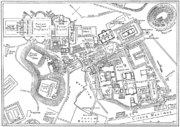
A map of central Rome during the Roman Empire, with the Colosseum at the upper right corner
Construction of the Colosseum began under the rule of the Emperor Vespasian[3] in around 70˝72AD. The site chosen was a flat area on the floor of a low valley between the Caelian, Esquiline and Palatine Hills, through which a canalised stream ran. By the 2nd century BC the area was densely inhabited. It was devastated by the Great Fire of Rome in AD 64, following which Nero seized much of the area to add to his personal domain. He built the grandiose Domus Aurea on the site, in front of which he created an artificial lake surrounded by pavilions, gardens and porticoes. The existing Aqua Claudia aqueduct was extended to supply water to the area and the gigantic bronze Colossus of Nero was set up nearby at the entrance to the Domus Aurea.[14]
Although the Colossus was preserved, much of the Domus Aurea was
torn down. The lake was filled in and the land reused as the location
for the new Flavian Amphitheatre. Gladiatorial schools and other
support buildings were constructed nearby within the former grounds of
the Domus Aurea. According to a reconstructed inscription found on the
site, "the emperor Vespasian ordered this new amphitheatre to be
erected from his general's share of the booty." This is thought to
refer to the vast quantity of treasure seized by the Romans following
their victory in the Great Jewish Revolt
in 70AD. The Colosseum can be thus interpreted as a great triumphal
monument built in the Roman tradition of celebrating great victories.[14]
Vespasian's decision to build the Colosseum on the site of Nero's lake
can also be seen as a populist gesture of returning to the people an
area of the city which Nero had appropriated for his own use. In
contrast to many other amphitheatres, which were located on the
outskirts of a city, the Colosseum was constructed in the city centre;
in effect, placing it both literally and symbolically at the heart of
Rome.
The Colosseum had been completed up to the third story by the time
of Vespasian's death in 79. The top level was finished and the building
inaugurated by his son, Titus, in 80.[3] Dio Cassius recounts that over 9,000 wild animals were killed during the inaugural games of the amphitheatre. The building was remodelled further under Vespasian's younger son, the newly designated Emperor Domitian, who constructed the hypogeum,
a series of underground tunnels used to house animals and slaves. He
also added a gallery to the top of the Colosseum to increase its seating capacity.
In 217, the Colosseum was badly damaged by a major fire (caused by lightning, according to Dio Cassius[15])
which destroyed the wooden upper levels of the amphitheatre's interior.
It was not fully repaired until about 240 and underwent further repairs
in 250 or 252 and again in 320. An inscription records the restoration
of various parts of the Colosseum under Theodosius II and Valentinian III
(reigned 425˝450), possibly to repair damage caused by a major
earthquake in 443; more work followed in 484 and 508. The arena
continued to be used for contests well into the 6th century, with
gladiatorial fights last mentioned around 435. Animal hunts continued
until at least 523.[14]
Medieval
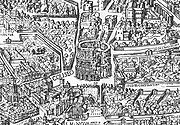
Map of medieval Rome depicting the Colosseum
The Colosseum underwent several radical changes of use during the
medieval period. By the late 6th century a small church had been built
into the structure of the amphitheatre, though this apparently did not
confer any particular religious significance on the building as a
whole. The arena was converted into a cemetery. The numerous vaulted
spaces in the arcades under the seating were converted into housing and
workshops, and are recorded as still being rented out as late as the
12th century. Around 1200 the Frangipani family took over the Colosseum and fortified it, apparently using it as a castle.
Severe damage was inflicted on the Colosseum by the great earthquake
in 1349, causing the outer south side, lying on a less stable
alluvional terrain, to collapse. Much of the tumbled stone was reused
to build palaces, churches, hospitals and other buildings elsewhere in
Rome. A religious order moved into the northern third of the Colosseum
in the mid-14th century and continued to inhabit it until as late as
the early 19th century. The interior of the amphitheatre was
extensively stripped of stone, which was reused elsewhere, or (in the
case of the marble fa┴ade) was burned to make quicklime.[14]
The bronze clamps which held the stonework together were pried or
hacked out of the walls, leaving numerous pockmarks which still scar
the building today.
Modern

Interior of the Colosseum, Rome. Thomas Cole, 1832. Note the Stations of the Cross around the arena and the extensive vegetation, both removed later in the 19th century.
During the 16th and 17th century, Church officials sought a productive role for the vast derelict hulk of the Colosseum. Pope Sixtus V
(1585˝1590) planned to turn the building into a wool factory to provide
employment for Rome's prostitutes, though this proposal fell through
with his premature death.[16] In 1671 Cardinal Altieri authorized its use for bullfights; a public outcry caused the idea to be hastily abandoned.
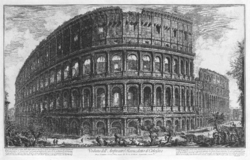
The Colosseum in a 1757 engraving by Giovanni Battista Piranesi
In 1749, Pope Benedict XIV endorsed as official Church policy the view that the Colosseum was a sacred site where early Christians had been martyred. He forbade the use of the Colosseum as a quarry and consecrated the building to the Passion of Christ and installed Stations of the Cross, declaring it sanctified by the blood of the Christian martyrs who perished there (see Christians and the Colosseum).
However there is no historical evidence to support Benedict's claim,
nor is there even any evidence that anyone prior to the 16th century
suggested this might be the case; the Catholic Encyclopedia concludes that there are no historical grounds
for the supposition. Later popes initiated various stabilization and
restoration projects, removing the extensive vegetation which had
overgrown the structure and threatened to damage it further. The fa┴ade
was reinforced with triangular brick wedges in 1807 and 1827, and the
interior was repaired in 1831, 1846 and in the 1930s. The arena
substructure was partly excavated in 1810˝1814 and 1874 and was fully
exposed under Benito Mussolini in the 1930s.[14]
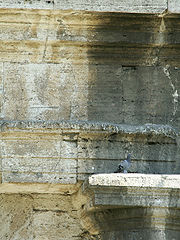
Between 1993 and 2000, parts of the outer wall were cleaned (left) to
repair the Colosseum from automobile exhaust damage (right)
The Colosseum is today one of Rome's most popular tourist
attractions, receiving millions of visitors annually. The effects of
pollution and general deterioration over time prompted a major
restoration programme carried out between 1993 and 2000, at a cost of
40 billion Italian lire ($19.3m / ─20.6m at 2000 prices). In recent years it has become a symbol of the international campaign against capital punishment,
which was abolished in Italy in 1948. Several anti˝death penalty
demonstrations took place in front of the Colosseum in 2000. Since that
time, as a gesture against the death penalty, the local authorities of
Rome change the color of the Colosseum's night time illumination from
white to gold whenever a person condemned to the death penalty anywhere
in the world gets their sentence commuted or is released,[17]
or if a jurisdiction abolishes the death penalty. Most recently, the
Colosseum was illuminated in gold when capital punishment was abolished
in the American state of New Mexico in April 2009.[18]
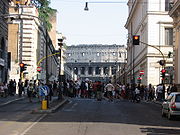
Today, the Colosseum is a background to the busy metropolis that is modern Rome.
Because of the ruined state of the interior, it is impractical to
use the Colosseum to host large events; only a few hundred spectators
can be accommodated in temporary seating. However, much larger concerts
have been held just outside, using the Colosseum as a backdrop.
Performers who have played at the Colosseum in recent years have
included Ray Charles (May 2002),[19] Paul McCartney (May 2003),[20] and Elton John (September 2005).[21]
On July 7, 2007, the Colosseum was voted as one of New Open World Corporation's New Seven Wonders of the World.